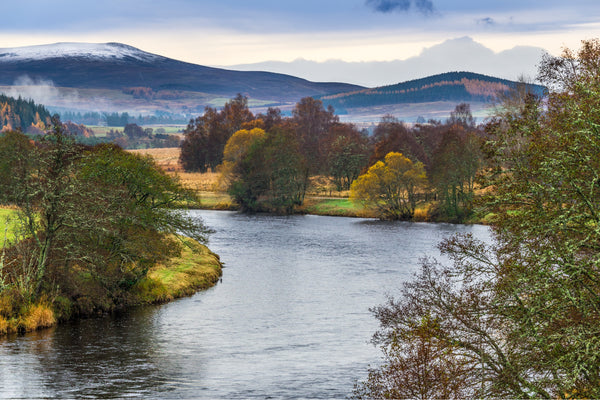Scorching summers may have once been a novelty in Scotland, but with rising temperatures, they're here to stay. What is the impact of a heatwave on whisky production? And in a changing climate, is the Angel's Share phenomenon becoming a threat to rare and aged whisky?
The petrichor arising from the hot tarmacked roads is abundant as pure, luscious drops of rain hit the ground and explode into tiny crystals, rewarding the Scottish flora and fauna with a much-needed drink after what has seemed to be a never-ending drought.
At the time of writing, Scotland has just emerged from weeks of relentless, scorching sunshine. Uncharacteristic for the nation, which is famed for its plentiful water supply, the arrival of rain has never been more welcome – for the bottlers who have baked within the concrete and metallic jungles of working plants, for the coopers who have endured exhausting temperatures as they’ve transported casks to and from, for the coppersmiths who welded on in blistering heat – and of course, the distillers who were worryingly observing water sources, for fear of a dwindling supply.
In the face of climate change, warmer and more extreme weather is likely to become a part of life for all whisky makers – from fighting rising tide lines, to the challenges of long, hot spells such as the one we have just experienced. But what sort of impact does a heatwave of this nature have on Scotch whisky production?

Water Source
As the old Scots proverb goes “today’s rain is tomorrow’s whisky”. An optimistic musing and reflection on Scotland’s infamously wet weather, no doubt, but in a literal sense, the creator could not have been more accurate.
Water sources are often the pride of a distillery – tour guides will wax lyrical on the purity of the fresh water source - be it a river, natural spring, or loch - and although the influence on water in the final flavour of a whisky is hotly debated, it is still very much a pivotal piece of distilling.
The production of whisky has always been tied to the climate, and this is one key reason as to the successful development of so many distilleries throughout Scotland, with an abundance of reliable water available due to the country’s wet weather.
Distilleries use a significant volume of water in the distilling process alone: from making wort, through to creating steam to heat stills and to cool to manipulate condensation. Over centuries this use has evolved to become an efficient and genuinely circular process, but only where water levels allow.
As many aficionados will know, Scotch distilleries often opt for a minimum of a two week “shut down” throughout the summer months to carry out essential maintenance – often motivated by insufficient source water levels.
In recent years, increasingly warmer weather has become even more so challenging, with distilleries having to shut down over the summer for extended periods beyond the norm. This reduces available production time and will inevitably have a measurable impact on availability of Scotch Whisky in the future – a sobering thought.

Barley
Beyond the water source, there are many other elements of whisky production that are challenged by rising temperatures. The cultivation of barley (and other grains for that matter) is one such problem.
The arable practice of growing barley is very much a fundamental part of whisky making. Considerably more flexible than its water counterpart, Scotch whisky law dictates that strictly speaking, barley does not need to be sourced from within Scotland, although most distilleries still rely locally on farmers to supply the crop, and in turn farmers on distilleries for the mutually beneficial return of draff, forming a locally beneficial economy for smaller rural communities.
Of course, there is the obvious problem of a lack of rainfall resulting in the failure of a barley crop. In recent years, with rising temperatures, there has been a scientific focus on developing drought resistant strains, but as seen in 2018, even with this innovation in mind, an extended heatwave throughout the UK resulted in an almost 8% decline of barley production.
Malting also suffers in the face of hot weather, and humid conditions can prompt the premature pre-germination of barley in field – an occurrence which reduces yield on the malting floor. Of course, Scottish farmers can look to warmer climates closer to the equator for technological advances to help manage this, but ultimately the remedy to manage this phenomenon will be expensive.
Warm and wet conditions will also affect the barley once harvested and transported to the malting floors. A change to a more humid environment could prompt rapid and uncontrollable germination – an occurrence that has been so regular as of recent years, has seen sizeable investment into temperature control across malting floors to manipulate the required conditions.
With this need to turn towards technological innovation, it bears the question: are our current whisky making methods at risk?

Maturation
With heatwave like temperatures, the process of maturation is also at risk.
The wet and relatively cool climate that has been associated with Scotland for centuries is considered one of the best environments in which to mature whisky. Relatively stable conditions enable the extended maturation of whisky in cask for decades due to a slower pace of oxidisation of spirit in contact with wood. This slow, patient process carves the way for new to develop nuanced esters and compounds that would otherwise be impossible over a shorter period. A warmer climate could lead to a less refined whisky, and natural evaporation of liquid within the cask, known as the Angel’s Share, would facilitate the aggressive impartment of flavours into the new make, resulting in a much less polished palate.
Scotch whisky which has traditionally been left to slumber in dunnage warehouses, is now matured on a variety of sites, some including temperature-controlled racked and palletised warehouses – a less romantic picture of whisky making. With this level of management, whisky makers can attempt to reduce drastic evaporation by the Angel’s Share, but not without the consequence of the loss of certain aspects, such as the loss of airflow – an influence which could impact the final flavour of a whisky.

Heatwaves and Whisky Production – The Changing Face of Scotch?
As Scotland braces itself for a permanent change in a warmer climate, these new constraints have forced the acceleration and introduction of new innovative technologies across the industry. It is estimated that by 2080, climate change will have influenced Scotch whisky to the point flavours will change, which means that more than ever before, Scotch whisky relics from a time gone past, such as Blended at Birth, A Singular Blend or really any of the House of Hazelwood rare and aged expressions, are even more covetable in their rarity.
As for the long-term impact of heatwaves on whisky production? Only time will tell.




